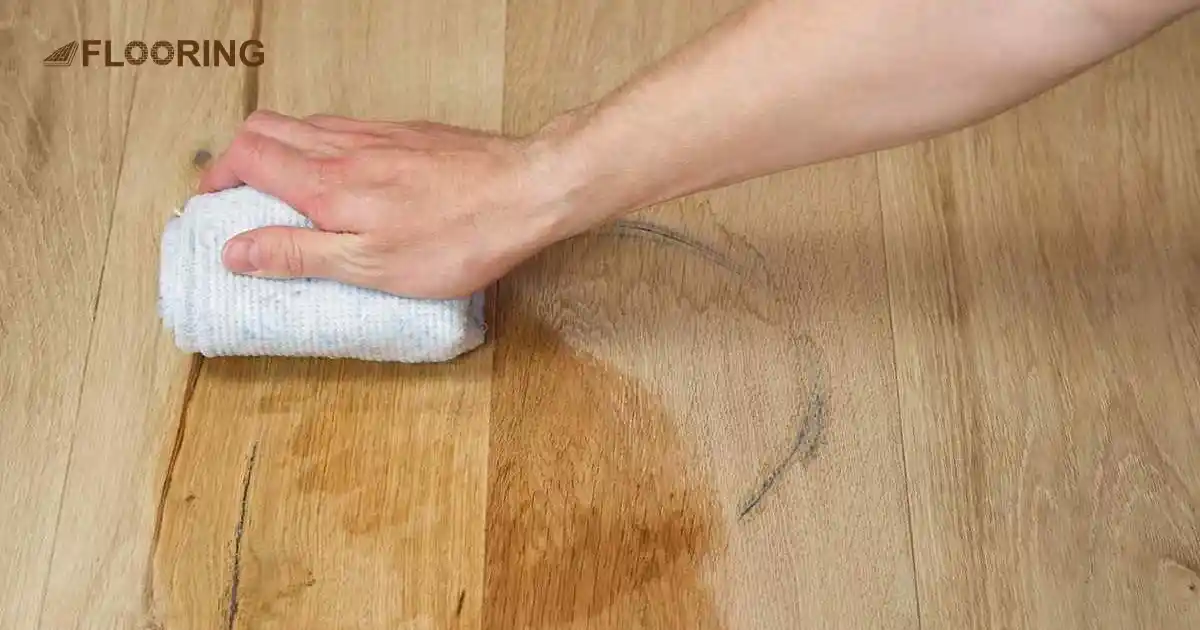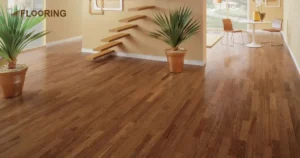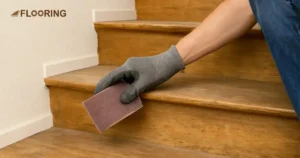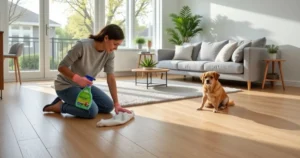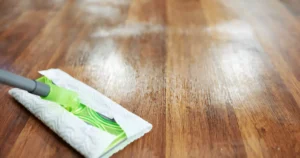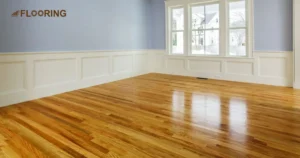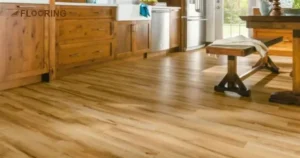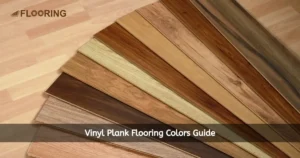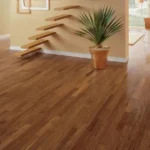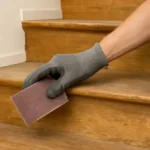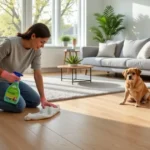Certain accidents are inevitable, no matter how hard we try to prevent them. When attempting to get stains out of hardwood floors, it’s important to act quickly and use appropriate cleaning techniques. But, the process can be trickier than dealing with stains on carpets when removing stains from a hardwood floor.
If you encounter stains on your hardwood floor, it’s crucial to understand how to get stains out of hardwood floors. Moisture and certain chemicals can damage hardwood floors, so it’s essential to use the proper cleaning methods. Using incorrect techniques could potentially cause more damage than the original stain.
In this post, we’ll show you the best way to remove various stains from hardwood floors and the simple steps to follow for a successful outcome.
📑 Table of Content
Key Takeaways
- Act fast to get stains out of hardwood floors: Immediate action can prevent stains from setting in and causing damage.
- Identify the type of stain to get them out of hardwood floors: Different stains require different treatments for effective removal.
- Use detergents while getting stains out of hardwood floors: Appropriate cleaning agents can help remove stubborn stains without harming the wood.
- Hydrogen peroxide: A powerful agent for removing tough stains on hardwood floors.
- Bar Keeper’s Friend: Effective in tackling various stains and maintaining wood quality.
- Nature’s Miracle: Ideal for removing pet stains and odors from hardwood floors.
- Pre-cleaning preparations: Ensure the floor is ready for cleaning by removing debris and dust.
- Regular cleaning and maintenance tips: Consistent care can prevent future stains and preserve the wood’s beauty.
Getting Stains Out of Hardwood Floors
Stains can come from various sources and require different approaches. The key to success lies in quick action, proper identification, and using the right cleaning methods. Let’s explore how to tackle this common household problem effectively.
Act Fast to Get Stain Out of Hardwood Floors
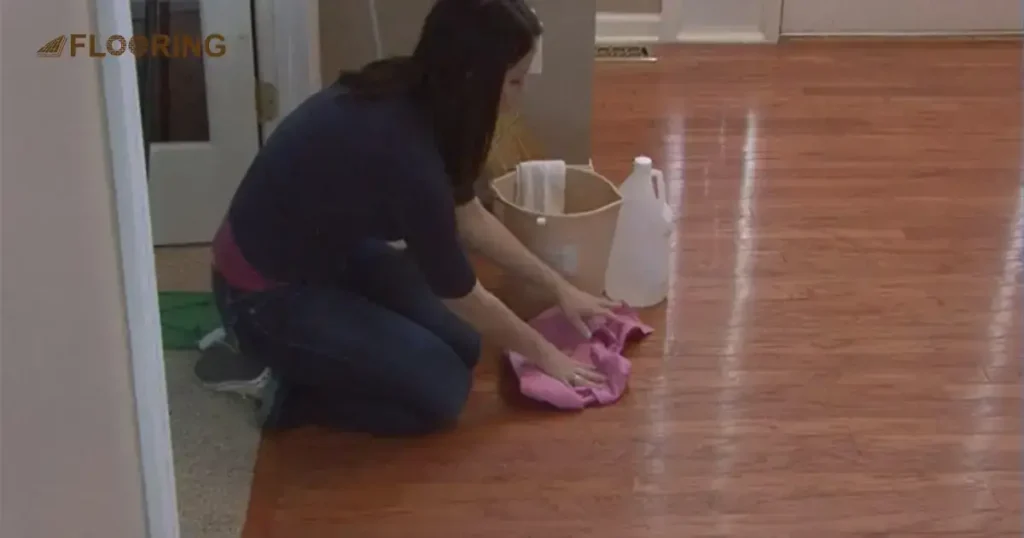
It is crucial to act promptly to protect your wood floors from stains. Cleaning up spills as soon as they occur will facilitate the stain-removal process.
Most of the time people overlook the porous nature of wood flooring. This characteristic allows liquids to penetrate the wood grain and be absorbed, resulting in challenging stain removal. The longer a stain remains on your wood floors, the more difficult it becomes to eliminate.
Therefore, it is important to promptly address any stains on your floor as soon as you notice them.
Identify the Type of Stain to Get them Out of Hardwood Floors
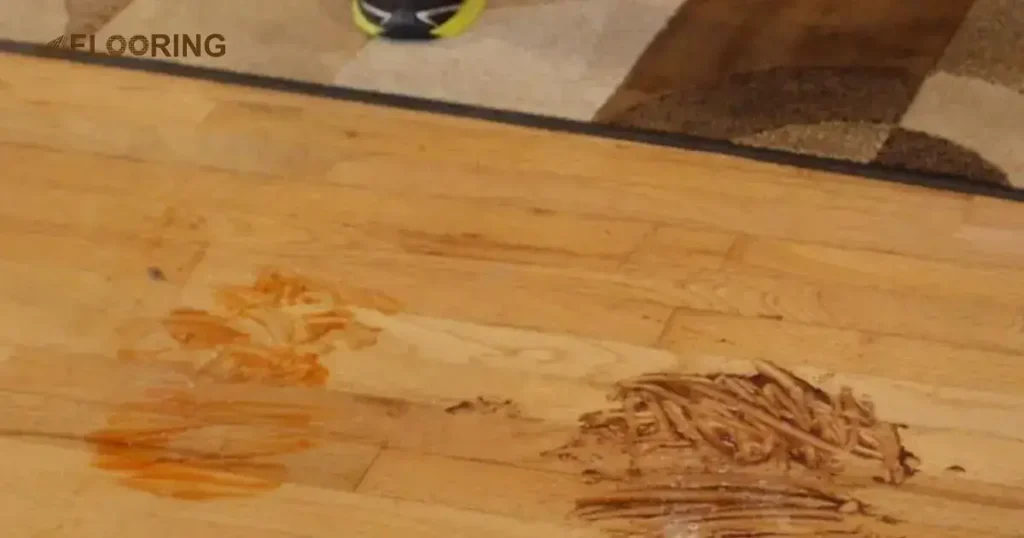
After that, it is essential to determine the nature of the stain at hand. Since various materials possess distinct characteristics, pinpointing the type of stain can facilitate the discovery of the most effective removal method.
If you encounter stains caused by greasy substances such as oil, it is advisable to utilize a natural degreaser to eliminate the stain effectively.
Use Detergents While Getting Stains Out of Hardwood Floors

Many individuals believe that costly hardwood floor cleaners are necessary to eliminate stains. Nevertheless, numerous household cleaners are available that can effectively remove most stains from hardwood floors. Before purchasing expensive stain removers, you should experiment with using detergents within your household.
Combining cold water with detergent is effective in treating ink spills and urine stains, efficiently eliminating blemishes from your hardwood floors. Due to the mild nature of detergents, you can trust that they will not damage the floor’s finish. Moreover, this method provides a safe option without the presence of harsh chemicals.
Use Baking Soda on Hardwood Floors to Get Stains Out
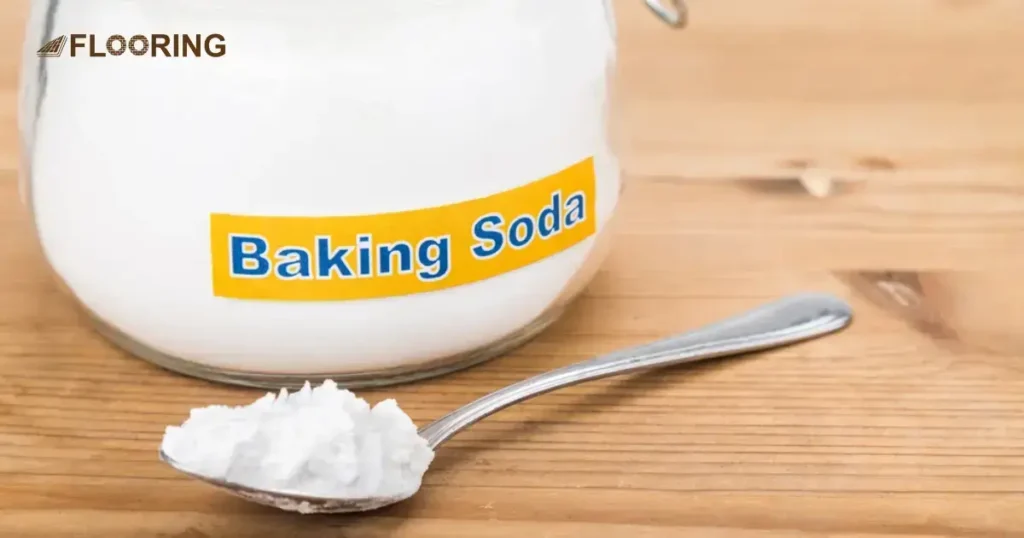
Baking soda is such a versatile product that you can utilize it for various household cleaning and beauty purposes. It is particularly effective in eliminating dye stains, especially when paired with vinegar.
Make a mixture of baking soda and vinegar and apply it to the stain, then gently scrub the stain with a rag or sponge until it begins to diminish. After the stain has been fully removed, you may use a damp cloth to wipe away any remaining residue.
Trying Vinegar on Hardwood Floors for Getting Stains Out
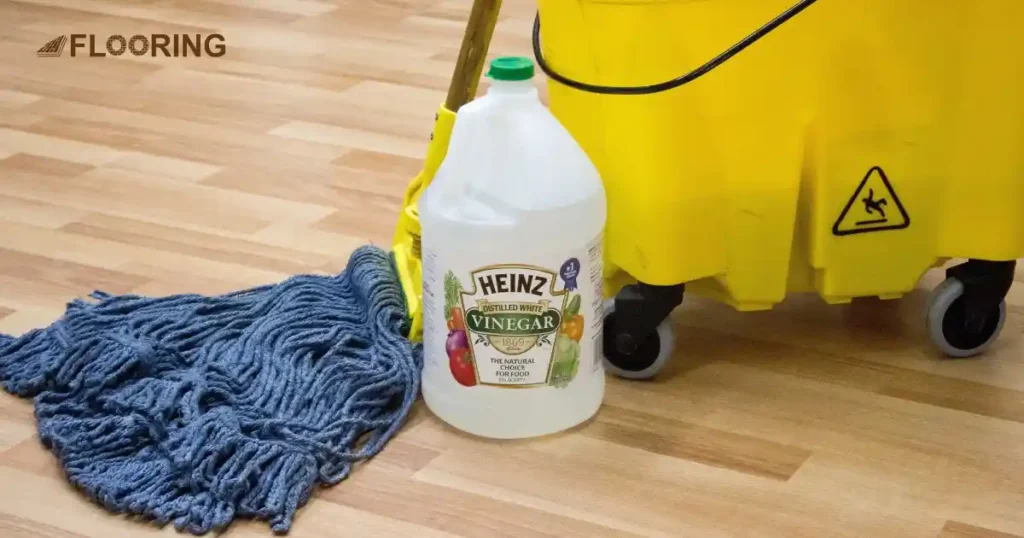
White vinegar is utilized for eco-friendly cleaning purposes. Due to its acidic nature, it effectively eliminates tough stains and dark spots from hardwood surfaces. However, it is advisable to dilute the vinegar with water before using it on your floors.
Soak a cloth in the solution and allow it to sit on the stain for some time before wiping it off.
Avoid Abrasive Scrubbers
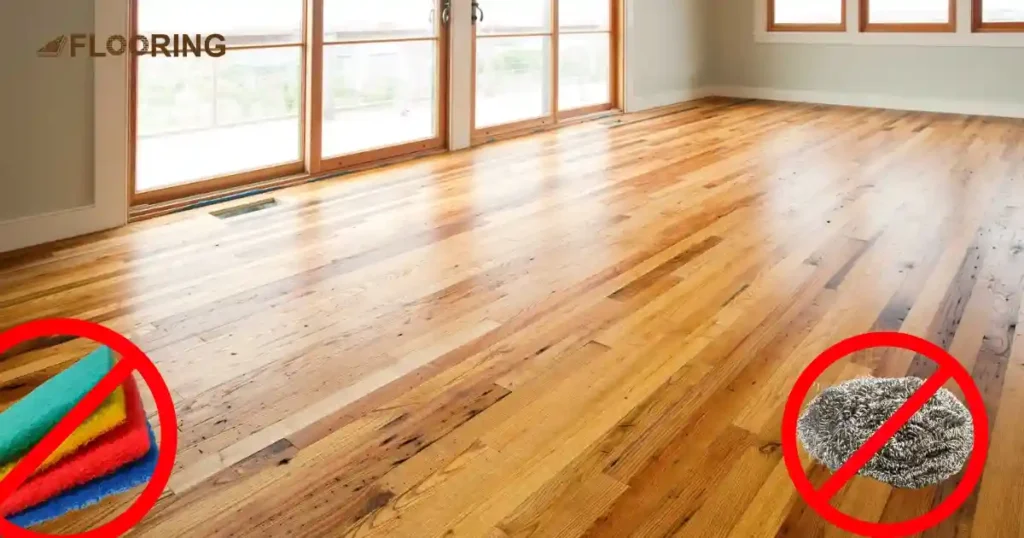
It is important to refrain from using abrasive scrubbers such as scouring pads or steel wool when removing stains from hardwood flooring. Although it may be tempting to use something abrasive to scrub away a stain, doing so can damage the finish of the flooring.
This occurs as it functions similarly to sandpaper, initiating the removal of the top coat and finish from your wooden floors. Utilizing a gentle cloth or sponge is advisable to address the stains on your hardwood surfaces.
Prioritize Routine Cleaning

It is crucial to understand that the most effective way to deal with stains on hardwood floors is through prevention. By making regular cleaning a priority, you can maintain the quality of your floors and avoid any unwanted discoloration.
It is crucial to promptly address spills on your floor to avoid liquid seeping into the wood grain. Regular cleaning guarantees that spills and stains are swiftly taken care of. Developing a routine of wiping down your floors daily is advisable, particularly if you have children or pets who tend to make a mess.
Sand and Refinish
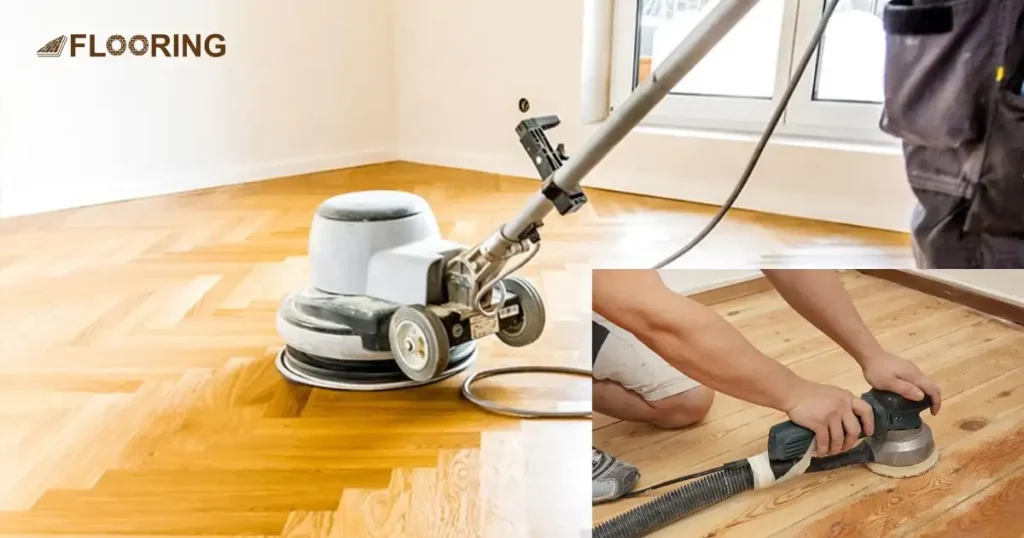
In case the stain is severe, you may need to sand and refinish your hardwood flooring. This process is not only effective in eliminating stains but can also address shallow scratches.
Utilizing this technique will give your flooring a fresh appearance! Additionally, you have the option to refinish only the damaged boards instead of the entire floor.
One downside to this stain removal suggestion is that your refinished floorboards might appear shinier and newer than the neighboring boards until they wear down and match in.
General Cleaning Tips for Hardwood Floors
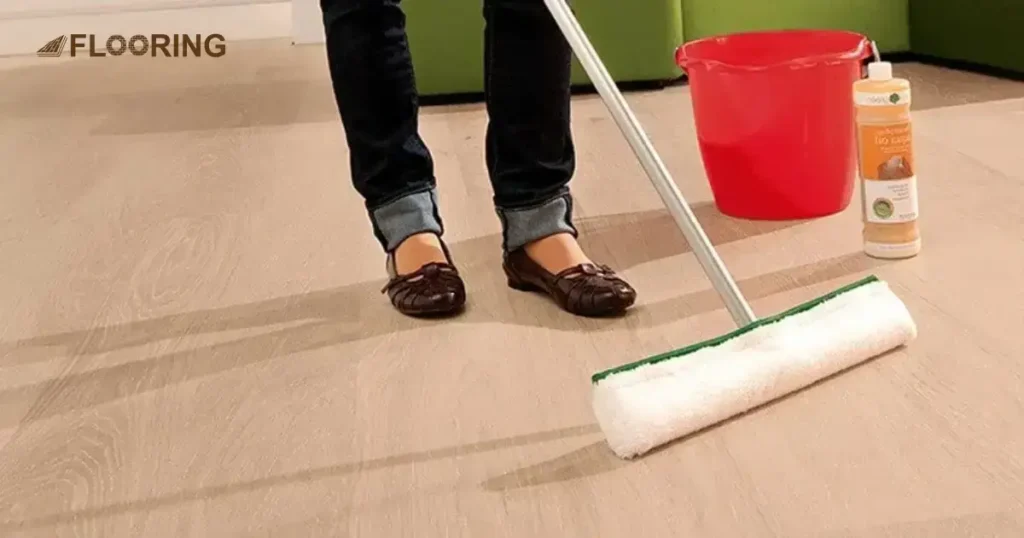
Regular Sweeping: Sweep your floors daily to remove dust and debris.
Use Soft Tools: Use a soft-bristled broom or a vacuum with a hardwood floor attachment.
Avoid Excess Water: Clean spills immediately to prevent water damage.
Use Gentle Cleaners: Choose pH-neutral cleaners specifically designed for hardwood floors.
Dry Thoroughly: Always dry your floors completely after cleaning to avoid moisture damage.
Protection from Furniture: Use furniture pads to prevent scratches and dents on hardwood floors.
Avoid Harsh Chemicals: Stay away from abrasive cleaners that can strip the finish.
Keeping your hardwood floors clean and well-maintained extends their life and preserves their beauty.
Pre-Cleaning Preparations
Before tackling any stain, gather all necessary cleaning supplies. This includes the following items you might need:
- A Soft Cloth
- A Mild Detergent
- A Bucket of Warm Water
- Stain Removers
Test your chosen cleaning solution on a small, inconspicuous area first to ensure it doesn’t damage the finish.
Also, ensure the area is well-ventilated to avoid inhaling any fumes from cleaning products. Having everything ready makes the cleaning process smoother and more effective.
How to Remove Surface-Level Stains
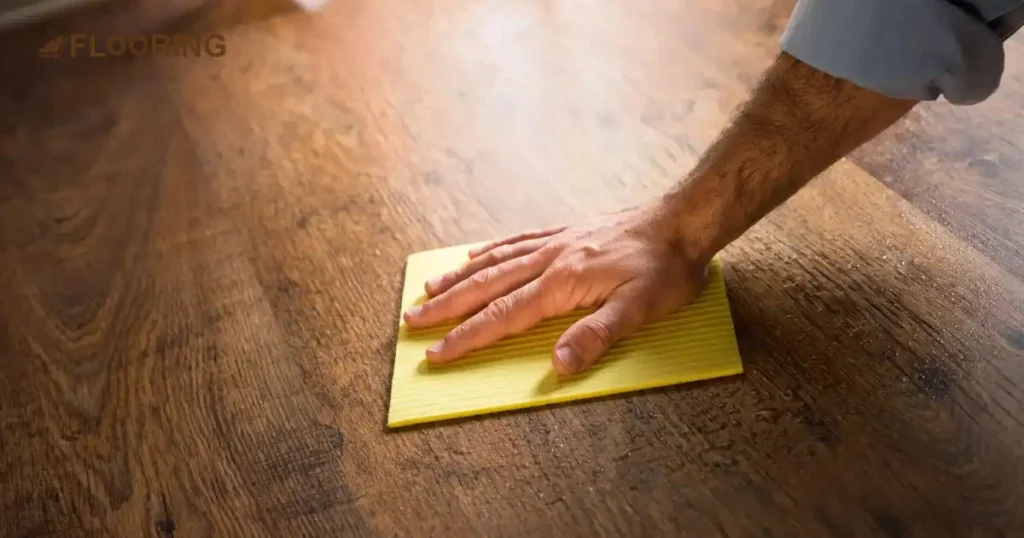
Follow these step-by-step guide to remove the stains from the surface of the hardwood floors:
Step 1 – Blot the Stain
Use a clean, dry cloth to blot up any excess liquid from the stain.
Step 2 – Prepare a Cleaning Solution
To prepare a cleaning solution, mix a small amount of mild detergent with warm water in a bucket.
Step 3 – Apply the Solution
Dip a soft cloth into the soapy water, then wring it out well and gently scrub the stained area.
Step 4 – Rinse the Area
Dampen another clean cloth with plain water and wipe away any soapy residue from the floor.
Step 5 – Dry the Floor
Use a dry cloth to thoroughly dry the cleaned area to prevent water damage.
Remove Tough Stains from Hardwood Floors
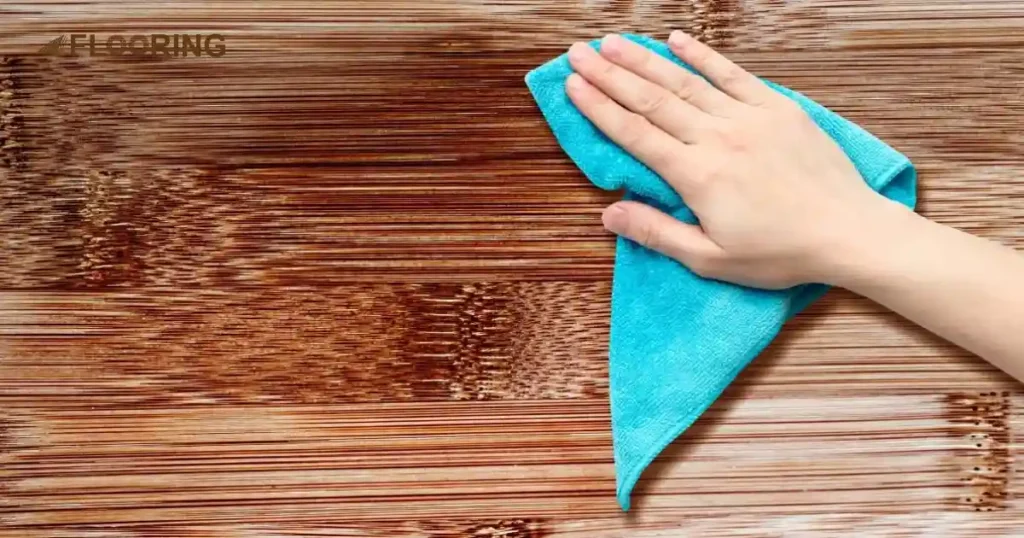
Dealing with stubborn stains can be quite challenging, especially when it comes to dark water spots on hardwood floors or trying to remove red wine stains that seem impossible to get rid of.
If that’s the situation, and you’ve attempted various techniques, you might need to consider sanding off the stain. It’s best to use this as a final option. Sanding is more effective for unfinished wood floors because it also removes some of the finish.
You only require a bit of light sandpaper and a gentle-bristled broom for this task.
Step 1 – Sand the Stain
Gently sand the stain until it is no longer visible. Be careful not to apply too much pressure, as it may result in damaging the wood and making the stain appear even worse.
Step 2 – Sweep Up the Excess Dust
Once you’re happy with the stain being gone, just sweep away any leftover dust.
How to Remove Oil Stains from A Hardwood Floor
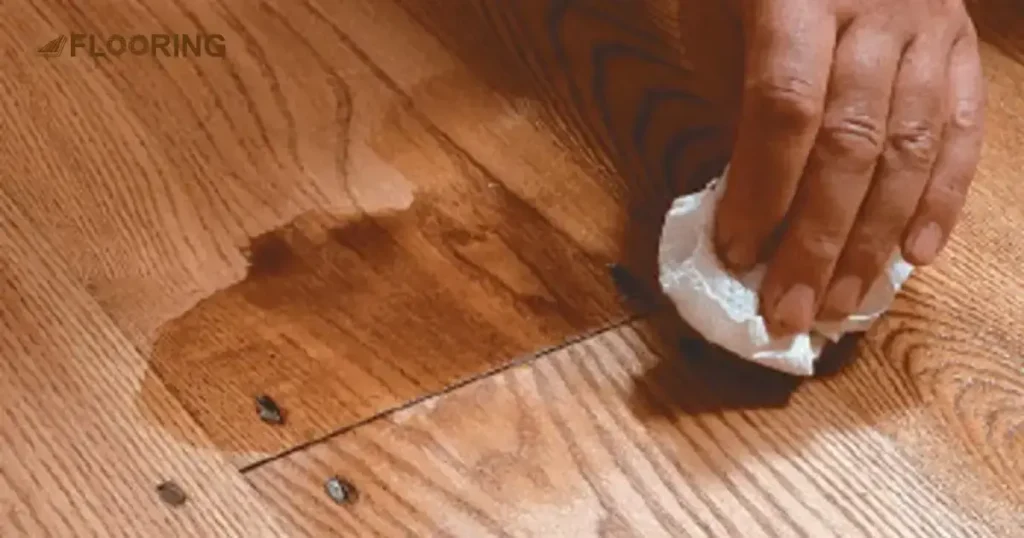
Accidentally spilling oil on the floor while cooking or doing other routine tasks can be a real hassle, especially if it’s hardwood. But don’t worry, there’s a safe and effective way to get rid of those stubborn oil stains from unfinished wood floors.
Step 1 – Gather Your Equipment
You will require specific items to remove oil stains from a hardwood floor, below, we have outlined them for you:
- Dishwashing Detergent
- Clean Paper Towels
- Flat Mop
- Water
- Orbot Vibe
Step 2 – Remove Any Excess Oil
Make sure to wipe away any leftover oil on the floor’s surface with fresh paper towels if it hasn’t been absorbed into the floor. Be sure to pat the oil instead of rubbing it. Rubbing will just cause it to penetrate deeper into the wood and make the stain more intense.
Step 3 – Mix Your Cleaning Mixture
Combine the dish soap with water, since it’s an oil stain, we suggest opting for warm water over cold water. This will assist in breaking it down.
Mix warm water and dishwashing detergent using 1 tbsp of dishwashing detergent and 1 cup of water. If the stain is tough, feel free to add extra dishwashing detergent to the mix.
Step 4 – Apply the Mixture
Remember to use a microfiber cloth to gently apply the mixture onto the stain. Keep in mind that hardwood floors can easily absorb water due to their porous nature, so be careful not to oversaturate the stain.
Make sure to squeeze out the excess water from the microfiber cloth before applying it to the stain to avoid using too much water.
Step 5 – Gently Rub the Stain
Carefully rub the wet cloth with the dishwashing solution onto the stain. You might have to repeat this process a couple of times to remove the stain. Keep in mind to be careful of the water you use on the stain, and aim to use as little as possible. Removing moisture from hardwood floors is more challenging than removing oil.
Step 6 – Use Flat Mop to Get Rid of Any Residue
Finally, grab a flat mop and some clean water to remove any leftover residue and soap from the floor.
Getting Rid of Liquid Stains on Hardwood Floors
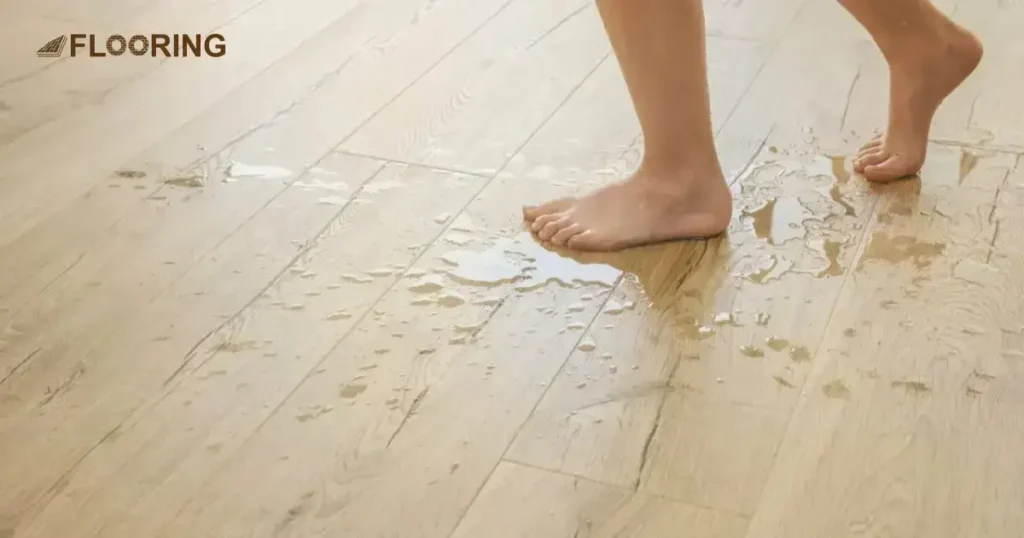
Liquid stains on hardwood floors can be a common problem, but they don’t have to be a permanent one. Whether it’s water, juice, or wine, addressing liquid stains promptly and using the right techniques can help restore your floor’s natural beauty.
Identifying the type of liquid stain is crucial for choosing the right cleaning method. Water stains typically leave white marks, while juice or wine stains might be darker. Knowing the stain type allows you to select the appropriate cleaning solution, ensuring effective removal without damaging your floors.
When dealing with liquid stains on wood floors, it’s important to act quickly. The longer the liquid sits, the more it can penetrate the wood and cause damage. Begin by blotting up the excess liquid with a clean, dry cloth.
For many liquid stains, a mild detergent can be very effective. Mix a small amount of detergent with warm water and use a soft cloth to gently scrub the stained area. Be sure to rinse the area with clean water afterward and dry it thoroughly.
Using Market-Based Hardwood Floor Cleaners
There are several market-based cleaners designed specifically for hardwood floors. These products can be highly effective for removing stubborn stains. Understanding the best options and how to use them will help you maintain your floors.
Hydrogen Peroxide
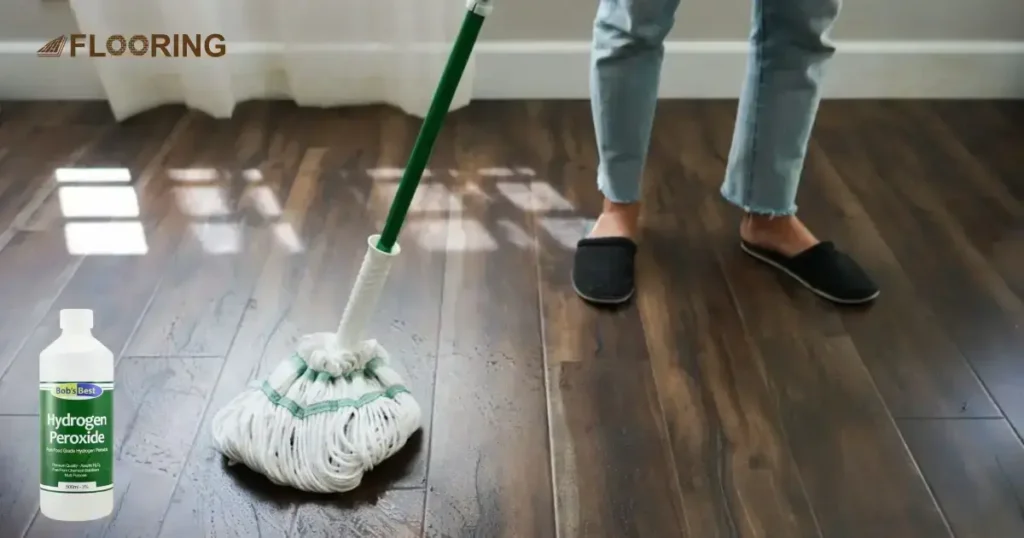
It is important to note that not all Hydrogen Peroxide solutions are identical. Ensure that you acquire a 3% Hydrogen Peroxide solution for the purpose of removing this stain. It is worth mentioning that Hydrogen Peroxide is commonly utilized as a bleaching agent.
Therefore be aware that it may result in some discoloration. Also, be sure to test it on a small area first to ensure it doesn’t affect the floor’s finish.
Bar Keeper’s Friend
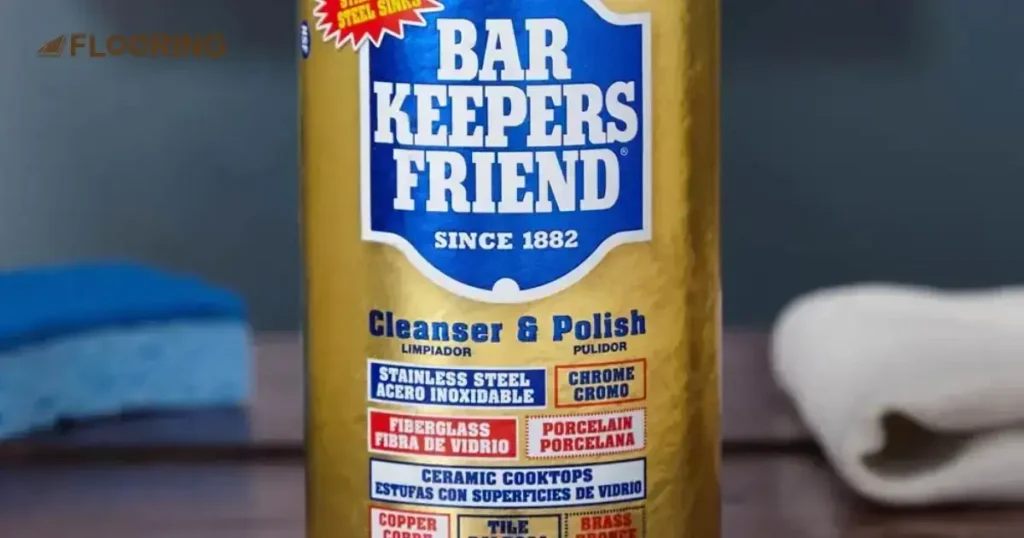
Bar Keeper’s Friend (BKF) is another effective stain remover for hardwood floors. BKF is now my preferred choice for tackling tough messes and stains that contain oxalic acid, which can lift tough stains. Sprinkle a small amount on a damp cloth and gently scrub the stained area then rinse with clean water and dry thoroughly.
Nature’s Miracle
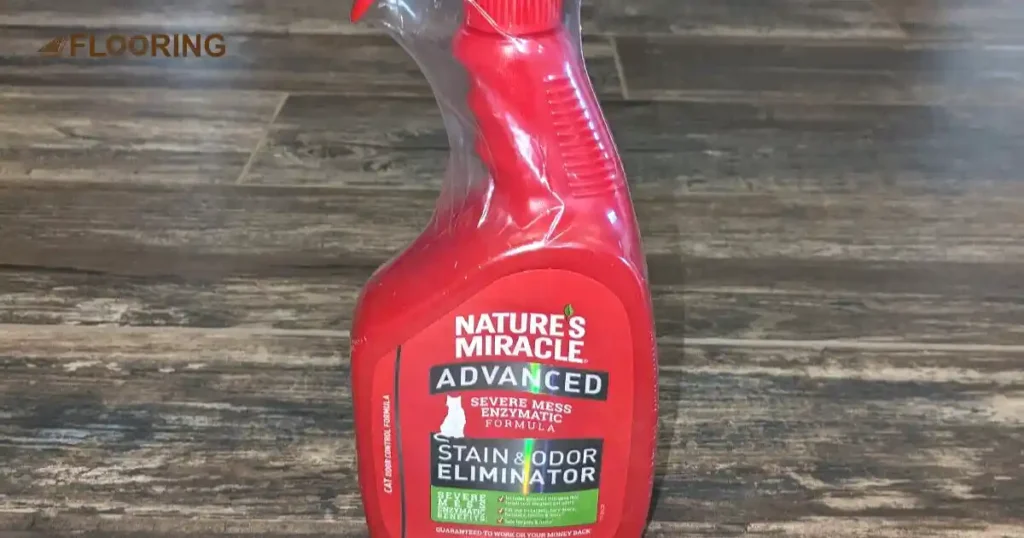
Nature’s Miracle is a bio-enzymatic cleaner that specializes in cleaning and deodorizing pet stains, especially on wood floors. By harnessing the power of “good” bacteria, this product effectively breaks down waste and soil, removing dark stains. Nature’s Miracle is widely recognized as the leading bio-enzymatic wood cleaner in the market.
Cleaning Different Types of Hardwood Floors
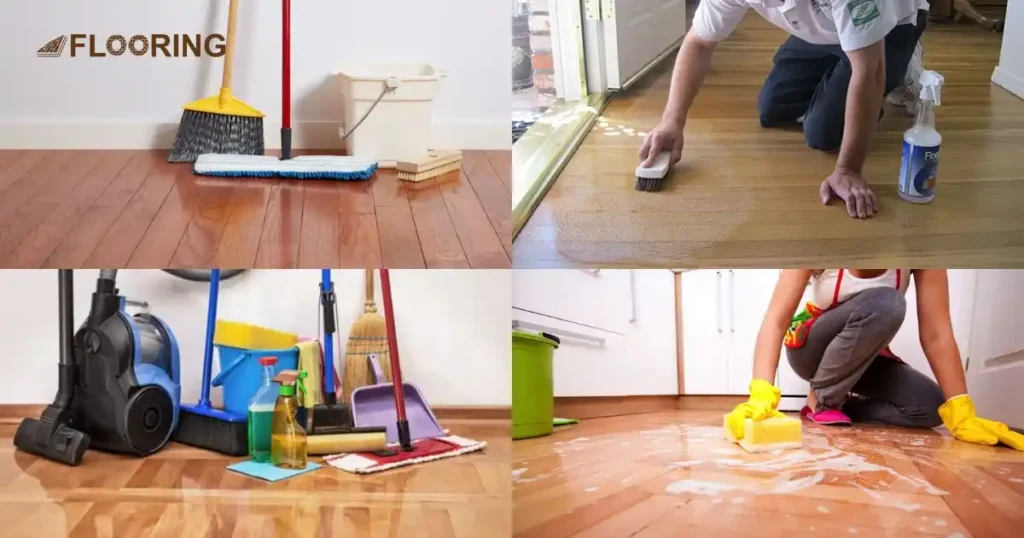
Cleaning different types of hardwood floors requires specific methods and products to ensure they remain in good condition. Each type of floor has unique needs that must be addressed properly.
Prefinished Hardwood Floors Cleaning
Prefinished hardwood floors have a factory-applied finish that makes them more resistant to stains. Use a pH-neutral cleaner and a soft mop to clean prefinished hardwood floors. Avoid using abrasive cleaners that can scratch the finish. Sweep or vacuum regularly to keep dirt and debris from scratching the surface.
Clean Engineered Hardwood Floors
Engineered hardwood floors are made of a top layer of real wood over a plywood base. Use a damp cloth with a mild cleaner to wipe down the surface. Avoid excessive water, which can damage the layers. Regularly clean engineered hardwood floors with a soft broom or vacuum to prevent scratches.
How to Clean Linoleum Floors
Linoleum floors are durable but require specific care to maintain their appearance. Use a mild cleaner and a damp mop for regular cleaning of Linoleum floors. Avoid using too much water, as it can seep into seams and cause damage. Regular sweeping helps prevent dirt buildup.
Clean Laminate Floors Without Leaving A Film
Laminate floors can be tricky to clean without leaving a film and use a laminate-specific cleaner and a microfiber mop. Avoid using wax or oil-based products, which can leave a residue. Vacuuming or sweeping can keep the surface of laminate floors clean and free of debris.
Preventing Future Stains on Hardwood Floors
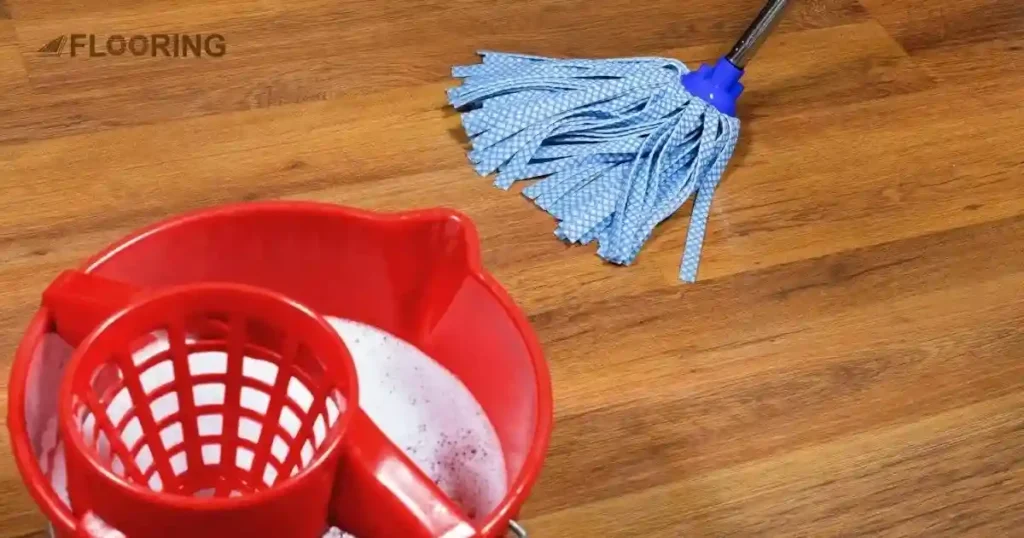
Preventing future stains on hardwood floors involves regular maintenance and using protective measures. This helps keep your floors looking beautiful and extends their lifespan.
Regular Cleaning and Maintenance Tips
- Sweep Daily: Keep floors free of dust and debris by sweeping every day.
- Use Soft Tools: Clean with soft-bristled brooms or vacuums designed for hardwood.
- Wipe Spills Promptly: You can Prevent stains by wiping up spills as soon as they occur.
- Use Gentle Cleaners: Opt for pH-neutral cleaners to avoid damaging the finish.
- Dry Floors Thoroughly: Always dry the floor completely after cleaning to prevent water damage.
Using Area Rugs and Furniture Pads
Placing area rugs in high-traffic areas can help protect your hardwood floors from stains and scratches. Furniture pads under the legs of chairs and tables prevent dents and gouges. By using these protective measures, you can reduce wear and tear on your floors and keep them looking new longer.
When to Call a Professional
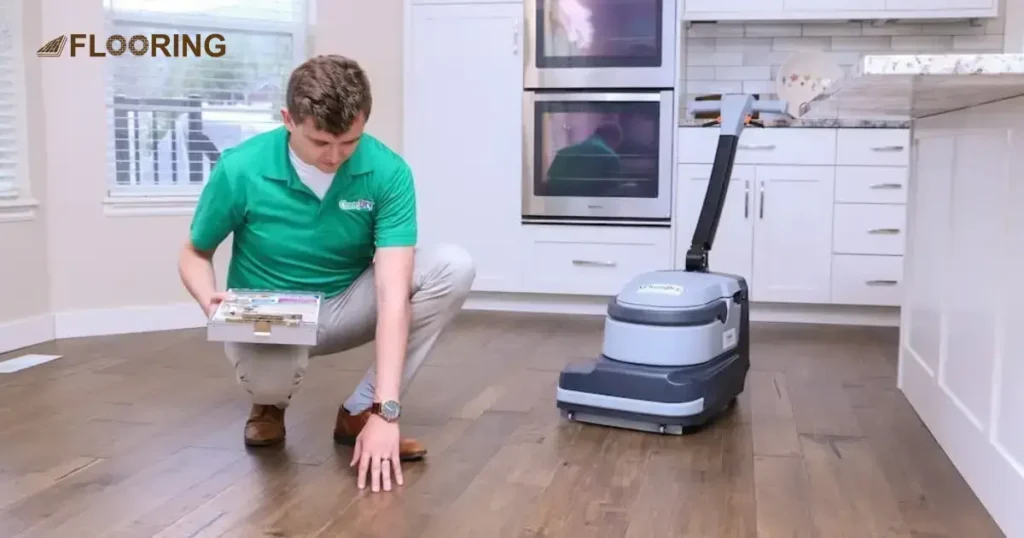
Knowing when to call a professional for hardwood floor stains can save time and preserve your floors. Some stains are too stubborn or extensive for DIY methods.
Identifying Stains That Need Expert Attention
Some stains on hardwood floors are best left to the professionals. Dark water stains, deep pet stains, and chemical spills can be challenging to remove without causing further damage. These types of stains often penetrate deep into the wood, requiring specialized treatment.
If DIY methods don’t work or if the stain is widespread, it’s time to call an expert to avoid worsening the problem.
Finding a Reliable Hardwood Floor Cleaning Service
Finding a reliable hardwood floor cleaning service involves a few key steps. First, research local services and read reviews from past customers then look for companies with certified technicians and a proven track record.
Ask for quotes and compare prices, but also consider the quality of service offered. It’s important to choose a service that uses safe, effective methods and has experience with your type of hardwood flooring.
Frequently Asked Questions
Does hydrogen peroxide remove stains on hardwood floors?
Yes, hydrogen peroxide can effectively remove stains on hardwood floors. When used in the proper concentration (3%), it can lighten and remove difficult stains without damaging the wood or finish.
How to remove dark stains from wood floor?
To remove dark stains from wood floors, use a mixture of vinegar and water, or apply hydrogen peroxide and let it sit for a few minutes, then gently scrub and wipe clean.
Is it OK to clean hardwood floors with vinegar?
While vinegar can be used to clean hardwood floors, it’s not recommended as a regular cleaning method. Vinegar is acidic and can dull the floor’s finish over time. It’s best to use a pH-neutral cleaner specifically designed for wood floors.
What product removes stains from hardwood floors?
Several products can effectively remove stains from hardwood floors, including oxalic acid, and commercial wood floor cleaners as I have already mentioned above in the article. Hydrogen peroxide is a reliable and affordable option that can lighten and remove various types of stains.
Does Dawn dish soap clean hardwood floors?
While Dawn dish soap can be used to clean hardwood floors, it’s not the best choice. Dish soap is designed to cut grease and may leave a film on the floor’s surface. It’s better to use a cleaner specifically formulated for wood floors.
Is Murphy’s oil soap good for hardwood floors?
Murphy’s Oil Soap is generally considered safe for hardwood floors when used as directed. It can effectively clean and leave a nice shine. However, some experts warn that it may leave a residue over time, so it’s best to use it occasionally rather than for regular cleaning.
How do you remove excess stains from hardwood floors?
To remove stains from hardwood floors that are excessive, start with gentle methods like a mixture of dish soap and warm water. If that doesn’t work, progress to specialized hardwood cleaners. For stubborn stains, you might need to sand and refinish the affected area.
Can I mop with Dawn and vinegar?
While you can mop with a mixture of Dawn and vinegar, it’s not the best option for hardwood floors. The vinegar’s acidity and Dawn’s residue can potentially damage the floor’s finish. It’s better to use cleaners specifically designed for hardwood floors.
What is the best thing to clean hardwood floors with?
The best way to clean hardwood floors is with a microfiber mop and a cleaner specifically designed for hardwood. Regular sweeping or vacuuming, followed by damp mopping with a pH-neutral hardwood floor cleaner, will keep your floors clean and protect their finish.
Conclusion
Maintaining the beauty of hardwood floors requires knowing how to get stains out of hardwood floors effectively. Using the right methods and products ensures that your floors remain pristine and free of damage. Whether dealing with liquid spills or deep-set stains, there are various techniques to address these challenges.
Regular maintenance and quick action are crucial in how to get stains out of hardwood floors. By following the steps and tips outlined, you can preserve the natural elegance of your hardwood floors. When in doubt, seeking professional help can prevent further damage and ensure your floors look their best.
The wood benefits of hardwood floors go beyond aesthetics, offering durability and longevity. Keeping them clean and stain-free not only enhances their appearance but also extends their life. Embrace the natural beauty and advantages of hardwood by caring for them properly.
